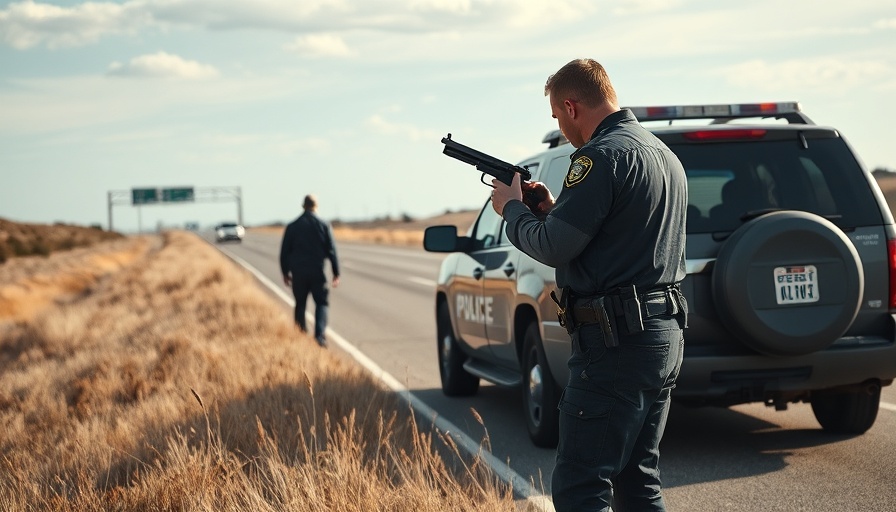
A Troubling Incident: Body Camera Footage Unveils Crisis in Law Enforcement
In an alarming incident in Boise, Idaho, newly released body camera footage has shed light on an officer-involved shooting that highlights the high-stakes environment in which law enforcement officers operate. The May 2025 revelation began a chain of events sparked by the Meridian police responding to reports of a man damaging a vehicle. What followed was a police pursuit that escalated to a distressing conclusion, illuminating the complexities around police encounters with individuals experiencing mental health crises.
The Pursuit of a Desperate Individual
The series of events unfolded on August 1, 2024, as officers from the Kuna Police Department and the Ada County Sheriff's Office became embroiled in a pursuit of a man who had fled after being reported for suspected criminal behavior. While the pursuit initially lost contact with the suspect, Kuna officers later located the vehicle, rekindling the chase only for it to take a harrowing turn. The suspect called 911 during the pursuit, communicating his despair by stating, “Can you tell my family I love them? Because I’m not going to jail.” His refusal to surrender accentuated the gravity of the situation, not just for him but for the officers trying to maintain public safety.
A Chilling Confrontation: The Moment of Use of Force
The culmination of the chase occurred when an officer executed a Precision Immobilization Technique (PIT) maneuver, bringing the suspect's vehicle to a stop. However, once the man exited his car brandishing a firearm, the situation escalated dramatically. Officers had no choice but to respond with lethal force, resulting in critical injuries to the suspect. This incident raises critical discussions regarding the decisions made by law enforcement officers under intense pressure and the protocols in place to address such confrontations.
Repercussions: The Legal Aftermath
The aftermath of the shooting revealed several startling facts, including the investigation led by the Ada County Critical Incident Task Force. Tests indicated that multiple rounds fired ricocheted, endangering nearby civilians and properties, which led to questions around police accountability and the strategies employed during high-pressure encounters. Notably, no injuries were reported among unintended targets, raising questions about the effectiveness of training and the potential for less lethal means of restraint.
Understanding Mental Health in Policing
The suspect's mental health played a crucial role in the incident. His statements during the pursuit indicate a deep psychological distress that was not adequately addressed before the confrontation. As public discussions around law enforcement reform and mental health intervention evolve, it is crucial that departments implement training focused on mental crisis management. Increasing the use of crisis negotiation teams and equipping officers with tools to recognize mental health issues could foster community trust and reduce the frequency of such tragic confrontations.
Future Directions for Law Enforcement Training
This incident underscores the importance of continuous training programs focusing on crisis de-escalation and mental health awareness among police forces. Engaging in community dialogues and law enforcement events allows police departments to reassess their strategies in building relationships with the public they serve. For most communities, knowing that officers are trained not just for enforcement, but also for empathy, is a critical step toward enhancing police-community relations.
The Path to Recovery: Legal and Community Insights
Post-incident, the suspect accepted a plea deal for charges of felony domestic battery and fleeing. Observing the legal ramifications provides insight into how systems can be improved for transparency in law enforcement operations. Additionally, open discussions in academic circles about police technologies, such as body cameras, can lead to improved guidelines on their use, further promoting accountability.
Conclusion: A Call for Action in Public Safety
As we reflect on such incidents, it is evident that they depict a microcosm of broader discussions around public safety and law enforcement practices. Ensuring officer wellness, reforming police training, and enhancing mental health strategies will not only put guardrails on future confrontations but will also hold law enforcement accountable to the communities they serve. In a landscape of increasing scrutiny, departments must embrace reforms that prioritize both community safety and mental health awareness.
 Add Row
Add Row  Add
Add 

 Add Element
Add Element 




Write A Comment